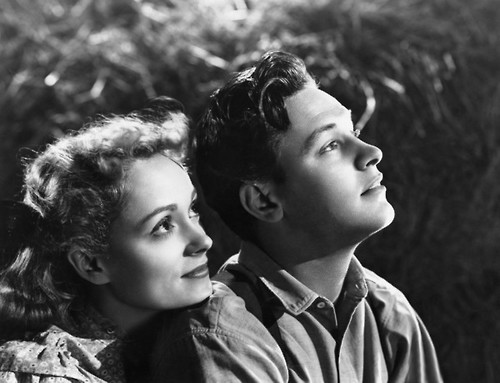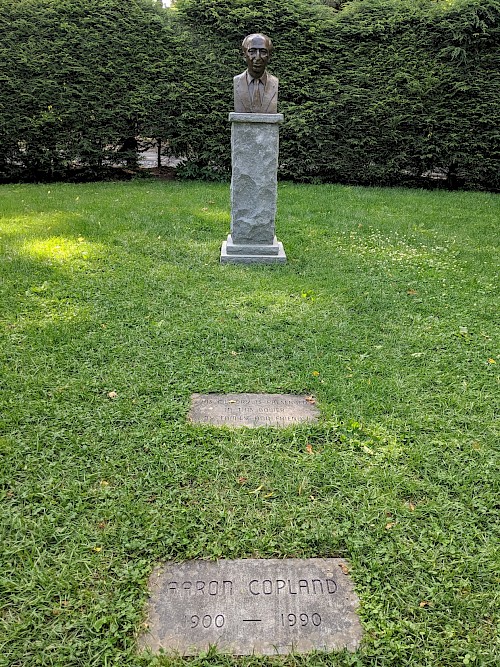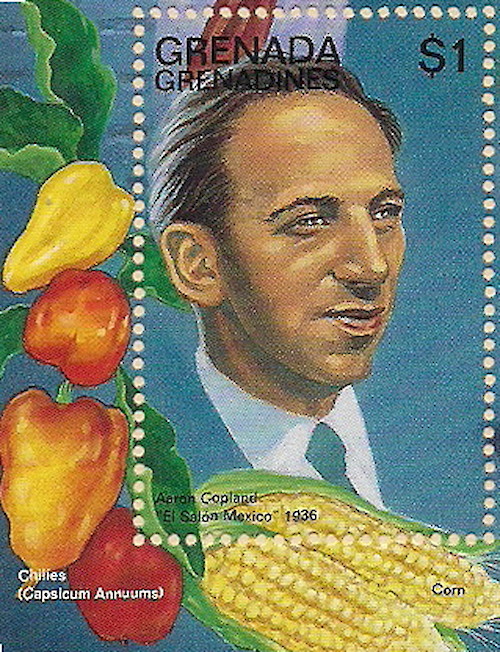Copland was not the sort to talk about “immortality,” but when asked how he would like to be remembered, he said simply, “I would like to be remembered through my music.” More than twenty years have passed since the composer’s death, and it is safe to say his wish has been granted. Fanfare for the Common Man continues to be what Bernstein called “America’s greatest hit”; the bounding rhythms of Billy The Kid and Rodeo still bring to mind cowboys, Indians, and the western plains; and Appalachian Spring is loved for its lyricism, especially Copland’s treatment of “The Gift to Be Simple.” The popular pieces that caused Copland to be called the “President of American Music” are still among the most performed and admired classical works worldwide, and Copland continues to be a beloved American icon. There are no signs of the customary silence that follows a composer’s death.

The revival of a forgotten composer may come about in many ways: admiring students, relatives, performers in search of new material, or an event, such as a centennial. Circumstances vary and serendipity usually plays a role. For Copland, there has been no break in popularity and no lack of performances--at least of the accessible pieces. The lively rhythms of “Hoedown” still set feet tapping, the trumpet blasts of Fanfare tempt listeners to stand and salute, the dissonant chord that accompanies the crunch of Curly’s hand in Of Mice And Men continues to make film audiences cringe, and Emily’s appearance in Our Town still brings forth tears. Copland did not expect his more thorny and intellectual pieces, those he dubbed his “neglected children,” to be accepted immediately; he knew they would be heard eventually and never lost confidence that all were deserving. The Piano Variations and the Third Symphony have joined Lincoln Portrait and El Salón México in the standard concert repertoire; Quiet City and the Piano Sonata are heard more and more. Copland’s place in the concert hall is secure.
We left Copland in his mid-eighties. He had ceased composing in the 1970s and stopped conducting in the 1980s. Throughout his career, he had been stimulated by new music and fresh ideas. He loved being part of the avant-garde and the movement for modern music. Copland was determined not to repeat himself in his music, and this may account for the size of his catalogue, which shows one or two examples of each genre -- a symphony, one piano quartet,. [sic] a trio, a nonet, a few ballet suites, one song cycle, a choral piece, film scores. Copland’s catalogue is not large--he considered himself a slow worker, a “one work-a-year-man,” but his oeuvre is varied, and as William Schuman pointed out, “there may be only one of each kind of music, but it’s likely to be the very best of its kind.”
Copland’s papers and manuscripts were sent to the Library of Congress. Rock Hill was closed and put up for sale. Ellis Freedman and I, together with Roger Levey, Sylvia Goldstein, David Walker and Ronald Caltabiano (who had succeeded David Walker) made the many contacts and announcements necessary at such times, not only out of a sense of duty and responsibility but with genuine admiration for a great composer and heartfelt affection for the man we had known and worked with for so long. Arrangements were soon underway for the Copland Memorial Concert at Alice Tully Hall, 20 April 1991. The event was co-produced by Harry Kraut (Bernstein’s long-time manager) and featured Lukas Foss conducting the American Composers Orchestra. Family and friends were invited to a gathering at the Century Club following the concert. One might say, life went on without Aaron Copland. But while he would no longer be seen in person or at concerts, or heard ‘live’ on radio and TV, the central core of Copland--his music--has stayed alive and well.

Some time later, Roger Levey (Copland’s great nephew and closest relative) called to discuss a time and place for burial of Copland’s ashes. We agreed that Tanglewood was appropriate, and Daniel Gustin, Tanglewood’s director and Copland’s friend, arranged for a site in the maze of hedges close to the Theatre-Concert Hall where Copland had spent so much time with students, composers, faculty, and audiences. Dan Gustin’s sensitive touch was evident in the simple and elegant event. Copland’s "As It Fell Upon a Day" was performed by gifted students as they walked slowly down the pathway by the grape arbor to a circle enclosed by green hedges that sparkled in the bright Berkshire sunshine. Following a brief welcome (Copland had requested no eulogy or religious service), guests were invited to sprinkle ashes around the grass fringe of the circle. At the entrance to the space there are three flat rectangular stones inconspicuously embedded in the grass. From top to bottom they read:
BEQUEATHED BY FAMILY AND FRIENDS
AARON COPLAND
1900-1990
THE FIRST THREE NOTES OF “FANFARE FOR THE COMMON MAN”
Praised for its eloquent simplicity, Copland’s burial place was not known to the public and rarely visited. Indeed, even on the Tanglewood staff, few knew such a tribute space existed. On 30 June, 2011, a handsome bronze bust of Copland was unveiled and placed in the center of Tanglewood’s hidden Copland circle. Lighting was installed to lead visitors to the burial place. The sculptor is Penelope Jenks; the tribute was sponsored by conductor John Williams, who hopes to place similar sculptures in appropriate places at Tanglewood to honor Serge Koussevitsky and Leonard Bernstein.
Copland’s Centenary coincided with the millennium, precipitating a flood of events in and around 2000. To name a few: Howard Pollack’s excellent biography, Aaron Copland, The Life and Works of an Uncommon Man, was published in 1999. The landmark occasion continued with concerts and festivals that featured American music, celebrated with a wide range of genres in various locations. The New York Philharmonic kicked off a year-long party with three weeks of “Completely Copland”; An all-Copland salute at Yale featured two premieres--the composer’s arrangement of Music for the Theatre for piano four-hands and his trio version of Prelude from the First Symphony for violin, piano, and cello; Boosey & Hawkes published an impressive brochure, featuring drawings by Al Hirschfeld, my annotations of Copland’s published music, and commentary by historian Carol Oja; critic Tim Page wrote a five-part series in the Washington Post. Among several video documentaries, a standout is Michael Tilson Thomas’ “Copland and the American Sound” with the San Francisco Symphony.

There is a particular satisfaction for researchers in the field of American music--the possibility of fresh discovery. One would think that the Copland mine would long have been exhausted, but performers and researchers are still tapping new areas and finding unexamined gems. With each “find” the balance shifts and the biography of Aaron Copland changes slightly. For example, “Music in the Twenties,” a DVD, has been released by Kultur; in it, Copland, filmed in 1965 at station WGBH in Boston, makes use of his lecture notes about the twenties discovered at the Library of Congress. It is a vivid mix of music and words about the 1920s, using the 1960s “new” technology of the video camera; the original score of Appalachian Spring has been located and has been examined for the first time in sixty years; an alternate text for the final aria of Copland’s only opera will alter future studies of The Tender Land; and someone will finally perform the two-piano arrangements of orchestral works made by Copland and John Kirkpatrick. Researchers will find that there is a Copland peak in Antarctica, a Copland Court in Maryland (between Stravinsky and Strauss Lanes), and a Copland stamp issued by the island of Grenada. The legend lives and grows, aided by Copland himself who bequeathed a large part of his estate to the support of new American music in the future. Younger composers, struggling to make their way in a difficult profession admire Copland’s legacy. His “rags to riches” story did not end with his death but has continued, providing proof positive that it is possible for a composer to “make it” on his own.
The Fund established in Copland’s name was first called The Aaron Copland Fund for Composers, but as its scope became clear, the title was broadened. Copland’s directives in his will were general and open to change: he asked only that his estate be used for the support of American music and composers, preferably under the age of forty. Copland’s Last Will and Testament was finalized with his attorney, Ellis J. Freedman, in 1984 (updating an earlier will of 1970).
The Copland Fund is an excellent example of the truism that organizations tend to take on the personality of those who establish them. Survivors who knew Copland have commented that the Copland Fund comes as close as possible to the composer’s intentions and aims during his lifetime. Frequently described as “modest,” Copland did not sponsor his own music, nor does the Fund exclude or include proposals on that basis. Its officers have leadership qualities in common with Copland. It was a very long time ago at a summer camp in the Adirondacks when the question, “What does Aaron think?” began to be heard. Throughout much of the twentieth-century, composers and colleagues repeatedly asked, “What does Aaron think?” The question still gently echoes at the Copland Fund board meetings, “What would Aaron think?”
Excerpted from “Postlude” to The Complete Copland (Hillsdale, NY: Pendragon Press, 2013), pp. 342-346.